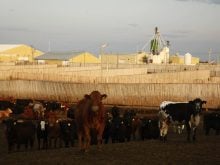This cattle market information is selected from the weekly report from Canfax, a division of the Canadian Cattlemen’s Association. More market information, analysis and statistics are available by becoming a Canfax subscriber by calling 403-275-5110 or at www.canfax.ca.
Fed cattle stronger
The fed steer weighted average was $160.31 per hundredweight, up 84 cents, and heifers were $159.77, up $1.53.
Dressed sales were steady to $4 per cwt. higher with most of the dressed trade at $268-$270 delivered.
Read Also

Huge Black Sea flax crop to provide stiff competition
Russia and Kazakhstan harvested huge flax crops and will be providing stiff competition in China and the EU.
The cash-to-futures basis weakened to +$4.73 but remained seasonally strong.
Weekly western Canadian fed slaughter to Jan. 7 was up seven percent at 23,497 head.
Positive feeding margins are pulling market supplies forward. In the week to Jan. 7, western Canadian steer carcass weights were 33 pounds less than the same week last year.
Weekly exports to Dec. 31 were modest at 1,913 head. Fed exports for 2016 totalled 315,115 head, up 46 percent from 2015.
Market-ready supplies are expected to increase moderately as warmer weather allows an opportunity to catch up on weight sorts.
However, reduced packer margins could slow slaughter until cut-out values can be revived.
The market is a long way from the highs of 2015, but prices are still strong, creating profit opportunities.
However, increasing meat supplies and uncertain global demand might push the market lower through the next couple of years of this cycle.
This recent rally is likely not a full trend change in prices but points to some market stability.
Cows firm
D1, D2 cows ranged $90-$104 to average $97.75 per cwt., up 25 cents from the previous week.
D3 cows ranged $80-$95 to average $86.50. Rail grade cows ranged $185-$190.
Alberta D1, D2 cows have a strong $20 per cwt. premium over U.S. utility cows.
The price spread between cows and bulls is seasonally narrowing.
The narrowest cow-bull spread in 2015 and 2016 was in January and widened in the spring.
With fewer cows on feed, cow slaughter volumes will likely trend below year ago levels.
Alberta prices are strong relative to the U.S. and Ontario markets, but there still is the potential for more seasonal price strength.
Feeder steers firm
Prices for heifers heavier than 800 lb. appeared slightly softer than the last week of 2016, while 500-650 lb. steers were stronger.
Short keep steers were also stronger.
Ontario steers heavier than 900 lb. are the strongest since late March, while Alberta steers are the strongest since early September.
Ontario steers 800 lb. and heavier are at a $12-$15 premium to the Alberta market.
There is no premium for February delivery over the cash market, but basis levels remain historically strong.
Steers 825-910 lb. for February delivery ranged from $169.25-$171.25.
Traditionally feeder exports pick up in the first quarter, but this year strong basis levels should keep more cattle in Canada.
Bred cows ranged $1,200 to $1,700.
U.S. beef lower
Following a seasonal trend, U.S. boxed beef prices to Jan. 12 were sharply lower with Choice at US$189.10, down $12.42 per cwt., and Select at $186.55, down $6.84 per cwt. Weekly Canadian cutout to Dec. 25 saw AAA at C$257.64, up $6.37 per cwt. and AA at $243.80, up $4 per cwt.
Even with the week-over-week increase, the Canadian cutouts were eight to nine percent lower than the same week last year.
















